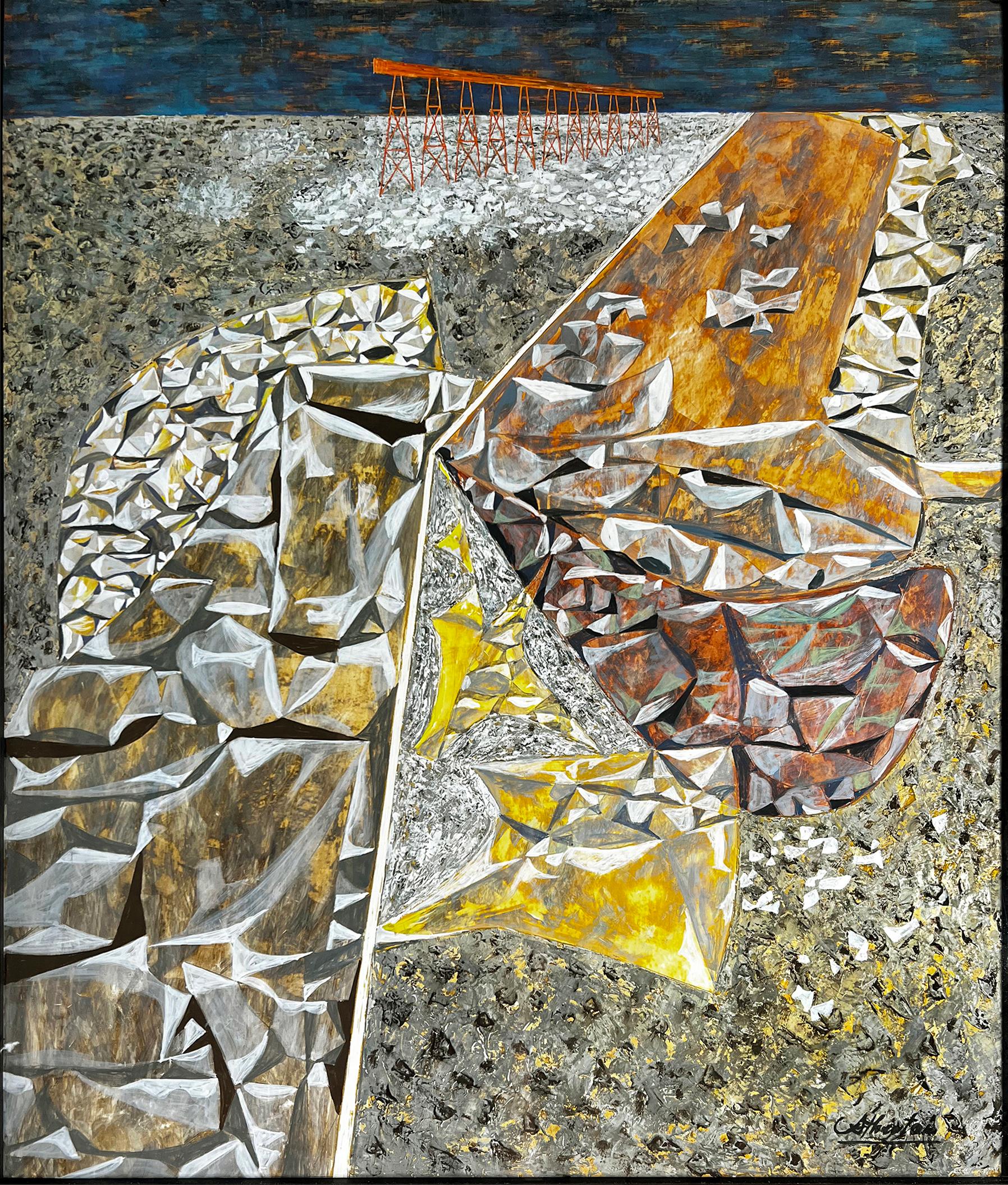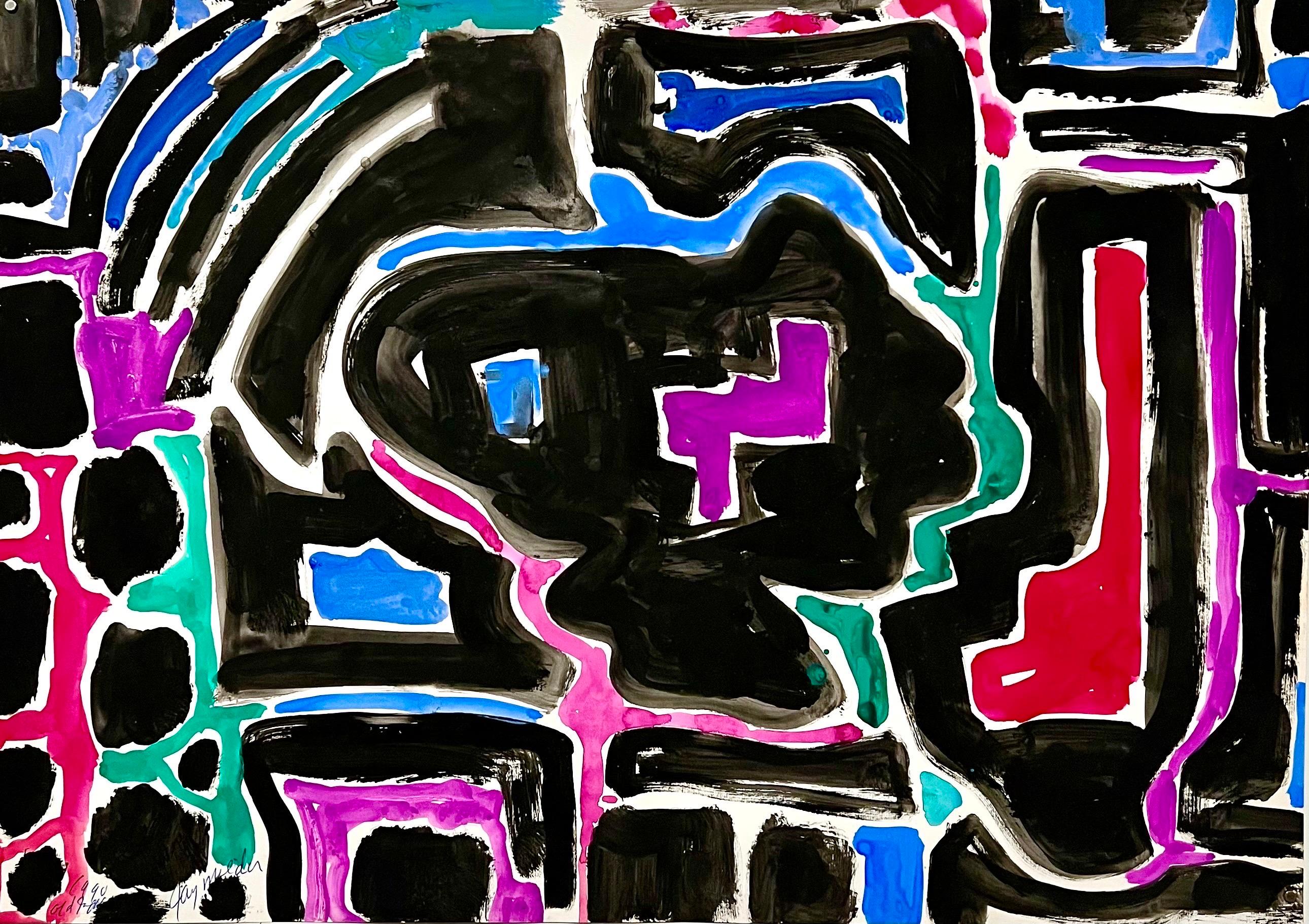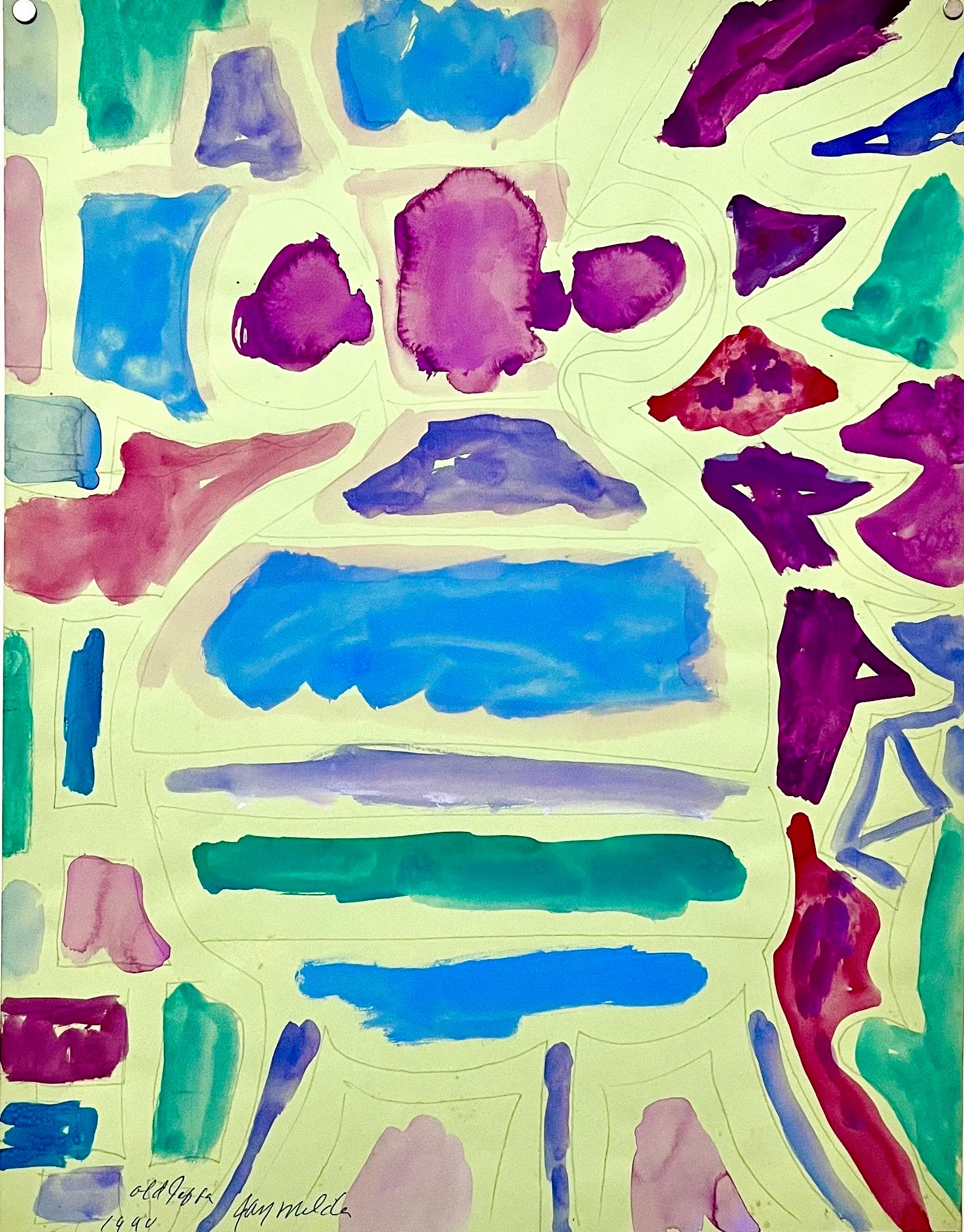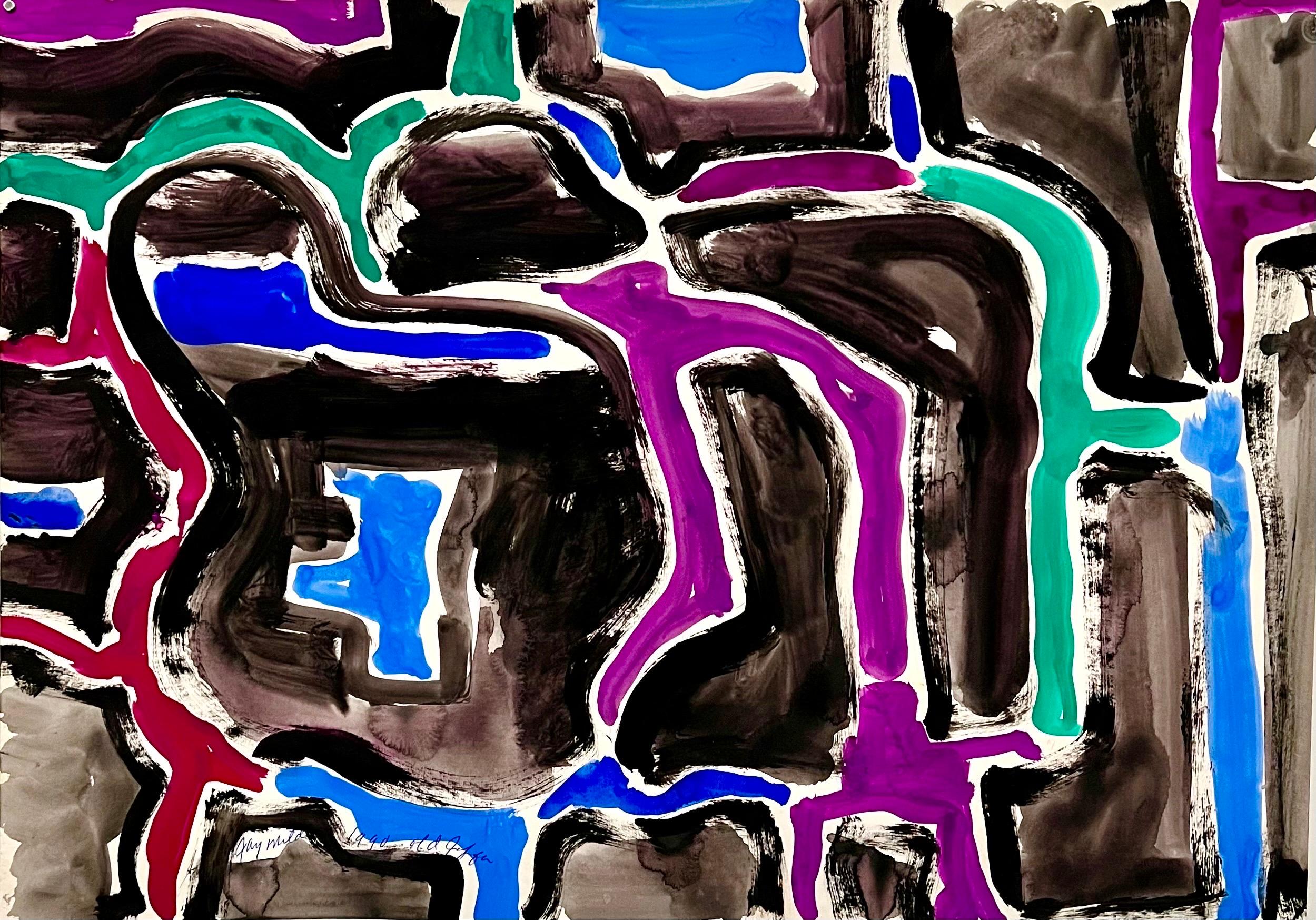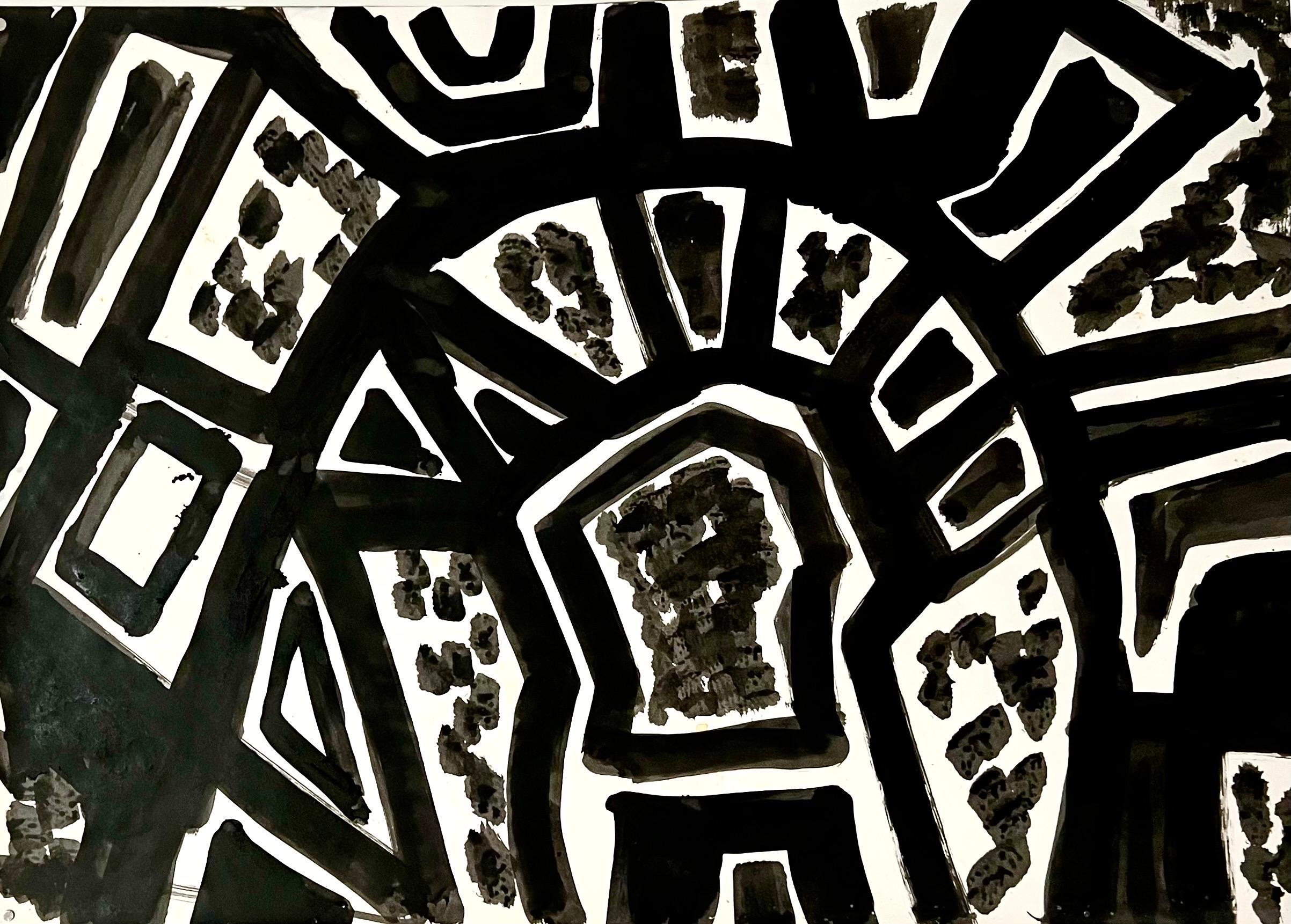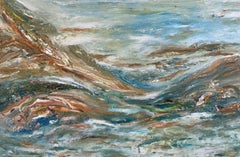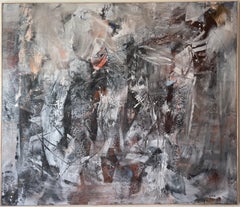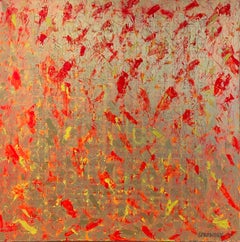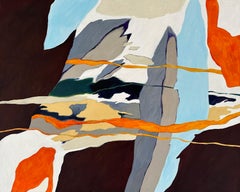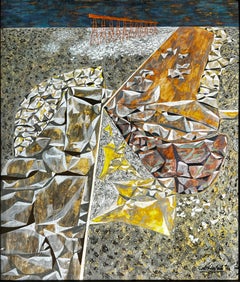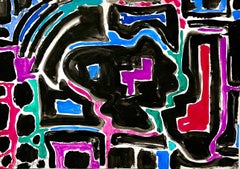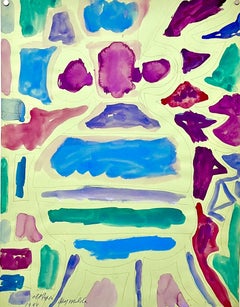Items Similar to French Feminine Contemporary Colorful Abstract Painting By Jean Pierre Guiot
Video Loading
Want more images or videos?
Request additional images or videos from the seller
1 of 13
Jean Pierre GuiotFrench Feminine Contemporary Colorful Abstract Painting By Jean Pierre Guiot1992
1992
About the Item
A beautiful and soft feminine gouache painting by French artist Jean Pierre Guiot. With a soft dark color palette of dark green, yellow, red, and blue, this piece exudes an emotional and floating look. The colors harmonize, creating a sense of motion that draws you into its narrative.
Jean-Pierre Guiot is a French Postwar & Contemporary painter born in 1935. The painting is a gouache on paper mounted on canvas, and is signed 'JP Guiot" and dated '92' in the lower right corner of the canvas. The unframed dimension of the painting is 14,9in (H) x 22,4in(W) / 38cm(H) x 57cm(W). The painting carries a black painted floating wooden frame and the framed dimension is 17,1in(H) x 24,6in(W) / 43,5cm(H) x 62,5cm(W). Please be aware that the painting has a few thin scratches on the middle of the surface of gouache. They are have been renovated but are still slightly visible upon close examination.
Arrives ready to hang.
- Creator:Jean Pierre Guiot (1935, French)
- Creation Year:1992
- Dimensions:Height: 14.97 in (38 cm)Width: 22.45 in (57 cm)
- Medium:
- Movement & Style:
- Period:
- Condition:A few thin scratches on canvas surface that has been renovated are present in the middle of canvas.
- Gallery Location:Frederiksberg C, DK
- Reference Number:1stDibs: LU2260213267852
About the Seller
5.0
Vetted Professional Seller
Every seller passes strict standards for authenticity and reliability
Established in 2021
1stDibs seller since 2022
15 sales on 1stDibs
Typical response time: 6 hours
- ShippingRetrieving quote...Shipping from: Hellerup, Denmark
- Return Policy
Authenticity Guarantee
In the unlikely event there’s an issue with an item’s authenticity, contact us within 1 year for a full refund. DetailsMoney-Back Guarantee
If your item is not as described, is damaged in transit, or does not arrive, contact us within 7 days for a full refund. Details24-Hour Cancellation
You have a 24-hour grace period in which to reconsider your purchase, with no questions asked.Vetted Professional Sellers
Our world-class sellers must adhere to strict standards for service and quality, maintaining the integrity of our listings.Price-Match Guarantee
If you find that a seller listed the same item for a lower price elsewhere, we’ll match it.Trusted Global Delivery
Our best-in-class carrier network provides specialized shipping options worldwide, including custom delivery.More From This Seller
View All"Am I Dreaming" Extra-Large Abstract Landscape With Mountains By Sophie Pollock
By Sophie Pollock
Located in Frederiksberg C, DK
Introducing "Am I Dreaming," an extra-large and captivating mountain landscape by contemporary artist Sophie Pollock. With each brushstroke, she captures the feel of dreamy mountains...
Category
2010s Abstract Expressionist Landscape Paintings
Materials
Canvas, Oil, Acrylic
French Extra-Large Grey And White Abstract Painting By Rapfaëlle Pia From 1987
By Raphaelle Pia
Located in Frederiksberg C, DK
Presenting a stunning extra-large French abstract acrylic painting by French artist Raphaëlle Pia (1942-). This contemporary artwork exhibits a remarkably vivid quality, achieved through the harmonious interplay of a pale color palette and bold, large brushstrokes.
The painting is countersigned. ‘R. Pia’ is signed in the bottom right corner of the canvas, and 'Raphaëlle PIA' is signed on the reverse side of the canvas. It is dated 1987, is titled ‘ ("Guanorgile") "Guanos II" ’, and its' medium is noted to be 'acrylique s/ toile (et technique mixte)' which translates to 'acrylic paint on canvas and mixed technique'. There is also a reference to a Parisian street that is partially crossed out...
Category
1980s Abstract Expressionist Abstract Paintings
Materials
Acrylic, Canvas
Large Gold And Orange Warm Contemporary Abstract Painting By Kenneth Strandby
Located in Frederiksberg C, DK
Presenting a large gold, orange, and yellow contemporary abstract painting by Danish artist Kenneth Strandby (1960 - ). With its color and its large size the painting has a warm and ...
Category
Early 2000s Abstract Abstract Paintings
Materials
Acrylic
"Step Carefully" Colorful And Vivid Orange Contemporary Abstract By Steffen Bue
By Steffen Bue
Located in Frederiksberg C, DK
"Step Carefully" is a contemporary abstract painting by Danish artist Steffen Bue who invites you to experience a vivid and dynamic creation. Its vib...
Category
2010s Abstract Abstract Paintings
Materials
Canvas, Acrylic
"Dream Coming True" Extra-Large Blue Contemporary Landscape By Sophie Pollock
By Sophie Pollock
Located in Frederiksberg C, DK
This artwork presents a dreamy blue abstract scenery by contemporary artist Sophie Pollock. With its soft nuances of blue and white, the color palette creates a soothing and serene a...
Category
2010s Abstract Landscape Paintings
Materials
Canvas, Oil, Acrylic
"Time Changes All" A Large Abstract With Earthy Colors By Steffen Bue
By Steffen Bue
Located in Frederiksberg C, DK
Introducing "Time Changes All", a mesmerizing abstract painting by contemporary Danish artist Steffen Bue.
This painting measures 100cm x 100cm, and it c...
Category
2010s Abstract Abstract Paintings
Materials
Canvas, Acrylic
You May Also Like
Red sun. 1969, gouache on paper, 59x70 cm
Located in Riga, LV
Red sun. 1969, gouache on paper, 59x70 cm
Gunars Klava (1933 – 1989)
Gunars Klava was born in 1933 in Priekule.
1953 - graduated from J. Rosenthal Art School
1964 - began to partic...
Category
1960s Abstract Expressionist Abstract Paintings
Materials
Paper, Gouache
Thought Provoking Rock Quarry - Mid Century Abstract
Located in Miami, FL
This meticulously planned, designed, and executed work depicts an ultra-wide angle view of a rock quarry/mine. The viewer looks down at close-up-stylized rock formations and then out at a horizon line with rust-colored mine trestles. Atherton hints at perspective with a broken white line that is wider in the foreground and tapers to a hairline as it recedes to the background. The work was done in 1951 at the height of America's most important art movement: Abstract Expressionism. John Atherton absorbs its influences but retains elements of representation. Atherton was an in-demand commercial artist who worked for most blue-chip clients. It is possible that this was an editorial assignment for Fortune Magazine. At the same time, Atherton was also a fine artist and the work could be an expression of pure creative pursuits. The work looks better in person and one can look at it for hours and not get bored. Look carefully and you may discover a deeper meaning in this painting of precisely arranged rocks. Signed lower right.
Brooklyn Museum of Art, New York, sold to benefit the acquisitions program
____________________
From Wikipedia, the free encyclopedia
John Carlton Atherton (January 7, 1900 - September 16, 1952) was an American painter and magazine illustrator, writer and designer. His works form part of numerous collections, including the Museum of Modern Art,[1] Whitney Museum of American Art and the Smithsonian American Art Museum.[2][3][4]
Early Years
He was the son of James Chester Atherton (1868-1928) and Carrie B. Martin (1871-1909). He was born in Brainerd, Minnesota.[5] His father was Canadian born. His parents relocated from Minnesota to Washington State, with his maternal grandparents whilst he was still an infant. He attended high school in Spokane, Washington.
Career
During his early years he never displayed an aptitude for art; rather, his first love being nature and the activities he relished there, mainly fishing and hunting. He enlisted in 1917, serving briefly in the U.S. Navy for a year during World War I. At the end of the war, determined to get an education he worked various part-time jobs, as a sign painter and playing a banjo in a dance band to pay his enrolment fee at the College of the Pacific and The California School of Fine Arts (now the San Francisco Art Institute). Once there, he also worked in the surrounding studios developing his oil painting techniques.
A first prize award of $500 at the annual exhibition of the Bohemian Club in 1929, financed his one way trip to New York City, which helped to launch his career as an artist.[6]
Atherton had aspired to be a fine artist, however his first paid jobs were for commercial art firms designing advertisements for corporations such as General Motors, Shell Oil, Container Corporation of America, and Dole. However, by 1936, encouraged primarily by friends, such as Alexander Brook, an acclaimed New York realist painter, he returned to the fine arts.
Atherton continued to accept numerous commissions for magazine illustrations; such as Fortune magazine, and over the years he would paint more than forty covers for The Saturday Evening Post starting with his December 1942 design, “Patient Dog.” This picture is reminiscent of his friend Norman Rockwell ‘Americana style’ and captures a poignant moment of nostalgia, where a loyal dog looks toward a wall of hunting equipment and a framed picture of his owner in military uniform.
Selected One person Exhibitions
Atherton accomplished his first one-man show in Manhattan in 1936. His Painting, “The Black Horse” won the $3000 fourth prize from among a pool of 14,000 entries. This painting forms part of the Metropolitan Museum of Art collection in New York.[7]
Atherton achieved recognition in New York City and elsewhere during the 1930s. Having exhibited at the Julien Levy Gallery in New York,[8] his paintings began to be collected by museums; including the Museum of Modern Art[9] and the Metropolitan Museum of Art.
His reputation increased with his art deco stone lithograph poster for the 1939 New York World's Fair. In 1941, his design won first place in the Museum of Modern Arts “National Defense Poster Competition”.
Selected Public Collections
Fleming Museum of Art, Burlington, Vermont
Albright-Knox Art Gallery,[10] Buffalo, NY
Art Institute of Chicago,[11] Chicago
Wadsworth Atheneum,[12] Hartford, CT
Brooklyn Museum of Art, New York
Metropolitan Museum of Art, New York
The Museum of Modern Art,[13] New York
Whitney Museum of American Art,[14] New York
Pennsylvania Academy of the Fine Arts,[15] Philadelphia
De Young Museum,[16] San Francisco
Smithsonian American Art Museum,[17] Washington DC
Butler Institute of American Art[18] Youngstown, OH
The Famous Artists School
Founded in 1948 in Westport, Connecticut, U.S.A. The idea was conceived by members of the New York Society of Illustrators (SOI), but due to the Society's legal status, could not be operated by it. SOI member Albert Dorne led the initiative to set up a separate entity, and recruited the support of Norman Rockwell, who was also an SOI member. For the founding faculty, Dorne recruited Atherton, as well as accomplished artists such as Austin Briggs, Stevan Dohanos, Robert Fawcett, Peter Helck, Fred Ludekens, Al Parker, Norman Rockwell, Ben Stahl, Harold von Schmidt and Jon Whitcomb.[19]
He collaborated with Jon Whitcomb with the book “How I Make a Picture: Lesson 1-9, Parts 1”.[20][21]
Society of Illustrators
Atherton as an active member from his arrival in New York. The society have owned many of his works. Ex-collection includes:
Rocking Horse (ca. 1949) [22]
Atherton, as his peers had many of his works framed by Henry Heydenryk Jr.[23]
Personal
On November 2, 1926, he married Polly “Maxine” Breese (1903-1997).[24][25] They had one daughter, Mary Atherton, born in 1932.
Atherton's often chose industrial landscapes, however found himself spending considerable time in Westport, Connecticut, with an active artistic community, and it became home for him, and his family. He then moved to Arlington, Vermont.[26]
Norman Rockwell enlisted Atherton in what was to be the only collaborative painting in his career.[27]
He was part of a group of artists including a Norman Rockwell, Mead Schaeffer and George Hughes who established residences in Arlington.[28] Atherton and Mead Schaeffer were avid fly fishermen and they carefully chose the location for the group,[29] conveniently located near the legendary Battenkill River.
In his free time, Atherton continued to enjoy fly-fishing.[30] He brought his artistic talent into the field of fishing,[31] when he wrote and illustrated the fishing classic, “The Fly and The Fish”.[32]
He died in New Brunswick, Canada in 1952,[33] at the age of 52 in a drowning accident while fly-fishing.[34]
Legacy
The Western Connecticut State University holds an extensive archive on this artist.[35]
His wife, Maxine also published a memoir “The Fly Fisher and the River” [36] She married Watson Wyckoff in 1960.
Ancestry
He is a direct descendant of James Atherton,[37][38] one of the First Settlers of New England; who arrived in Dorchester, Massachusetts in the 1630s.
His direct ancestor, Benjamin Atherton was from Colonial Massachusetts...
Category
1950s Abstract Expressionist Abstract Paintings
Materials
Mixed Media, Gouache, Board
Abstract Israeli Landscape Jay Milder Rhino Horn Painting Jaffa, Israel Pop Art
By Jay Milder
Located in Surfside, FL
This came from the collection of the Horace Richter Gallery
These were done in the 1990's
Hand signed and dated by the artist. Old Jaffa
Jay Milder (born 1934) is an American artist and a figurative expressionist painter of the second generation New York School. Old Testament themes such as Jacob's Ladder and Noah’s Ark, and the Jewish mystical beliefs of the Kabbalah, are recurring themes in Milder’s paintings which are presented as archetypal images that recur in the basic karma, make-up and need of human nature. Internationally exhibited, Milder is included in the collections of many national and international museums.
He has been the subject of two, recent retrospectives in Brazil in 2007 at the National Museum Brasilia and, in 2006, at the Museum of Modern Art, in Rio de Janeiro. He is renowned in Sao Paulo, one of the major international centers for street and public art, as a seminal influence on graffiti artists. Jay Milder was born in Omaha, Nebraska, in 1934. His grandparents, who came from the Ukraine, were descendants of the Hasidic mystic, Rabbi Nachman. As he listened to family stories his interest in spiritualism and mysticism increased, and became an important influence on his philosophy of life and art. Later, when he arrived in New York, he was drawn to the Theosophical Society and the teaching of Helena Blavatsky.
In 1954 Milder visited Europe where he studied painting with André L’Hote, and sculpture with Ossip Zadkine. He spent much time studying at the Louvre Museum, and at the studio of Stanley Hayter. During his Paris years the paintings of the Jewish painter Chaim Soutine, primarily influenced him. Milder returned to the United States in 1956, and he began studying painting at the Chicago Art Institute. He exhibited with the Momentum Group, an alliance of artists who were particularly dedicated to the progression of figurative art and its global origins.
In 1957, Milder spent the summer in Mexico for a summer where he exhibited in Puebla. That year he received the Mexican Government’s Honor Award for artists.
In the summer of 1958, Milder studied with Hans Hofmann in Provincetown, Massachusetts. He exhibited his work at the Sun Gallery, with his contemporaries, including Mary Frank, Red Grooms, Bob Thompson...
Category
20th Century Abstract Expressionist Abstract Paintings
Materials
Paper, Gouache
Abstract Expressionist Landscape Jay Milder Rhino Horn Painting American Pop Art
By Jay Milder
Located in Surfside, FL
This came from the collection of the Horace Richter Gallery, Old jaffa, Israel
These were done in the 1990's
Hand signed and dated. titled Old Jaffa.
Jay Milder (born 1934) is an American artist and a figurative expressionist painter of the second generation New York School. Old Testament themes such as Jacob's Ladder and Noah’s Ark, and the Jewish mystical beliefs of the Kabbalah, are recurring themes in Milder’s paintings which are presented as archetypal images that recur in the basic karma, make-up and need of human nature. Internationally exhibited, Milder is included in the collections of many national and international museums.
He has been the subject of two, recent retrospectives in Brazil in 2007 at the National Museum Brasilia and, in 2006, at the Museum of Modern Art, in Rio de Janeiro. He is renowned in Sao Paulo, one of the major international centers for street and public art, as a seminal influence on graffiti artists. Jay Milder was born in Omaha, Nebraska, in 1934. His grandparents, who came from the Ukraine, were descendants of the Hasidic mystic, Rabbi Nachman. As he listened to family stories his interest in spiritualism and mysticism increased, and became an important influence on his philosophy of life and art. Later, when he arrived in New York, he was drawn to the Theosophical Society and the teaching of Helena Blavatsky.
In 1954 Milder visited Europe where he studied painting with André L’Hote, and sculpture with Ossip Zadkine. He spent much time studying at the Louvre Museum, and at the studio of Stanley Hayter. During his Paris years the paintings of the Jewish painter Chaim Soutine, primarily influenced him. Milder returned to the United States in 1956, and he began studying painting at the Chicago Art Institute. He exhibited with the Momentum Group, an alliance of artists who were particularly dedicated to the progression of figurative art and its global origins.
In 1957, Milder spent the summer in Mexico for a summer where he exhibited in Puebla. That year he received the Mexican Government’s Honor Award for artists.
In the summer of 1958, Milder studied with Hans Hofmann in Provincetown, Massachusetts. He exhibited his work at the Sun Gallery, with his contemporaries, including Mary Frank, Red Grooms, Bob Thompson...
Category
20th Century Abstract Expressionist Abstract Paintings
Materials
Paper, Gouache
Abstract Expressionism Jay Milder Rhino Horn Painting Bold Colorful Pop Art
By Jay Milder
Located in Surfside, FL
This came from the collection of the Horace Richter Gallery
These were done in the 1990's
Hand signed and dated by the artist. Old Jaffa
Jay Milder (born 1934) is an American artist and a figurative expressionist painter of the second generation New York School. Old Testament themes such as Jacob's Ladder and Noah’s Ark, and the Jewish mystical beliefs of the Kabbalah, are recurring themes in Milder’s paintings which are presented as archetypal images that recur in the basic karma, make-up and need of human nature. Internationally exhibited, Milder is included in the collections of many national and international museums.
He has been the subject of two, recent retrospectives in Brazil in 2007 at the National Museum Brasilia and, in 2006, at the Museum of Modern Art, in Rio de Janeiro. He is renowned in Sao Paulo, one of the major international centers for street and public art, as a seminal influence on graffiti artists. Jay Milder was born in Omaha, Nebraska, in 1934. His grandparents, who came from the Ukraine, were descendants of the Hasidic mystic, Rabbi Nachman. As he listened to family stories his interest in spiritualism and mysticism increased, and became an important influence on his philosophy of life and art. Later, when he arrived in New York, he was drawn to the Theosophical Society and the teaching of Helena Blavatsky.
In 1954 Milder visited Europe where he studied painting with André L’Hote, and sculpture with Ossip Zadkine. He spent much time studying at the Louvre Museum, and at the studio of Stanley Hayter. During his Paris years the paintings of the Jewish painter Chaim Soutine, primarily influenced him. Milder returned to the United States in 1956, and he began studying painting at the Chicago Art Institute. He exhibited with the Momentum Group, an alliance of artists who were particularly dedicated to the progression of figurative art and its global origins.
In 1957, Milder spent the summer in Mexico for a summer where he exhibited in Puebla. That year he received the Mexican Government’s Honor Award for artists.
In the summer of 1958, Milder studied with Hans Hofmann in Provincetown, Massachusetts. He exhibited his work at the Sun Gallery, with his contemporaries, including Mary Frank, Red Grooms, Bob Thompson...
Category
20th Century Abstract Expressionist Abstract Paintings
Materials
Paper, Gouache
Abstract Expressionist Landscape Jay Milder Rhino Horn Painting American Pop Art
By Jay Milder
Located in Surfside, FL
This came from the collection of the Horace Richter Gallery
These were done in the 1990's
This does not appear to be hand signed. It is signed and dated verso perhaps by gallerist.
Jay Milder (born 1934) is an American artist and a figurative expressionist painter of the second generation New York School. Old Testament themes such as Jacob's Ladder and Noah’s Ark, and the Jewish mystical beliefs of the Kabbalah, are recurring themes in Milder’s paintings which are presented as archetypal images that recur in the basic karma, make-up and need of human nature. Internationally exhibited, Milder is included in the collections of many national and international museums.
He has been the subject of two, recent retrospectives in Brazil in 2007 at the National Museum Brasilia and, in 2006, at the Museum of Modern Art, in Rio de Janeiro. He is renowned in Sao Paulo, one of the major international centers for street and public art, as a seminal influence on graffiti artists. Jay Milder was born in Omaha, Nebraska, in 1934. His grandparents, who came from the Ukraine, were descendants of the Hasidic mystic, Rabbi Nachman. As he listened to family stories his interest in spiritualism and mysticism increased, and became an important influence on his philosophy of life and art. Later, when he arrived in New York, he was drawn to the Theosophical Society and the teaching of Helena Blavatsky.
In 1954 Milder visited Europe where he studied painting with André L’Hote, and sculpture with Ossip Zadkine. He spent much time studying at the Louvre Museum, and at the studio of Stanley Hayter. During his Paris years the paintings of the Jewish painter Chaim Soutine, primarily influenced him. Milder returned to the United States in 1956, and he began studying painting at the Chicago Art Institute. He exhibited with the Momentum Group, an alliance of artists who were particularly dedicated to the progression of figurative art and its global origins.
In 1957, Milder spent the summer in Mexico for a summer where he exhibited in Puebla. That year he received the Mexican Government’s Honor Award for artists.
In the summer of 1958, Milder studied with Hans Hofmann in Provincetown, Massachusetts. He exhibited his work at the Sun Gallery, with his contemporaries, including Mary Frank, Red Grooms, Bob Thompson, Lester Johnson, Emilio Cruz and Alex Katz, among others. During this period his painting began to incorporate iconography of birds, animals, humans and animal/human hybrids. In 1958, Milder, Bob Thompson and Red Grooms, founded the City Gallery in the Chelsea section of New York City. The gallery moved downtown and became the Delancey Street Museum and an early site for ‘Happenings’,which Milder participated in.
He showed his first major series called Subway Runners in 1960 at the Martha Jackson Gallery in New York City. Milder began a group of smaller paintings, entitled “Messiah Series”, in the late 1960s. These were fully expressionistic earth toned pictures, and he completed around 250 paintings in the series, based on biblical themes from the Old Testament. When 40 of these paintings were shown in a traveling exhibition premiering at the Richard Green Gallery in New York City, in 1987, art critic Donald Kuspit wrote in ArtForum Magazine: “after Nolde’s biblical pictures, these are the best and most integral group of biblical pictures in the 20th century.”
During the 1970s, Milder co-founded a collective group called Rhino Horn with Peter Passuntino, Peter Dean, Benny Andrews, Nicholas Sperakis, Michael Fauerbach, Ken Bowman, Leonel Gongora, and Bill Barrell...
Category
20th Century Abstract Expressionist Abstract Paintings
Materials
Paper, Gouache
Recently Viewed
View AllMore Ways To Browse
Wooden Painters Palette
Jp France
Jp French
Canvas Painting On Top Of Mirror
Chameleon Art
William Henry Jackson
Ben Thomas
De Stijl Mondrian
Frank Newman
Orange Crate Art
Ski Oil Painting
Artist First Name Lee
Bay Area Abstract Expressionism
Chinese Rice Paper Painting
Christopher Peter
Collage Stripe
Green Flash Painting
Modern Abstract Mid Century Auctions
